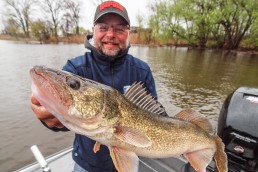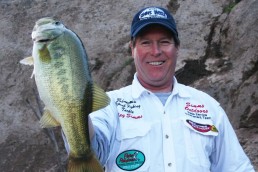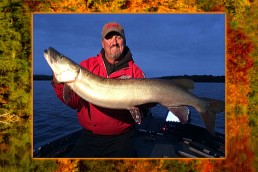Midsummer into Fall, a Crankbait Can do it All
SHARE THIS POST
Crankbaits work wonders year round; but choosing the right one as the seasons change is crucial
Whether I’m casting or trolling, by far my favorite lure to use is a crankbait.
A flip of the lid of any of my tackle totes will prove that—they’re almost all filled with Rapalas of all shapes and sizes, each model with a specific action of its own. I use them often, late summer through fall, no matter what species I am targeting; whether it’s in reservoirs, rivers, natural lakes or the Great Lakes.
But not every crankbait is perfect for every situation.
Take the lures I use throughout the transition of mid-summer through early-fall, for example. While one lure may take more fish due to its shape, size and dive curve during the month of July, for example, a totally different one may work better by September.
And with the loads of lures on the market today, the consideration of choosing the right one for the time of year you’re fishing can be overwhelming. But it’s not as difficult as you may think.
With that said, I’ll dissect the basic mid-summer through fall seasonal patterns of walleye, and how choosing the right crankbaits will help you catch more no matter where and how you fish.
In the now, in the know
By midsummer, the majority of walleyes have moved to main-lake basins. They’re here because most of the forage is here as well.
Baitfish this time of year will oftentimes suspend high in the water column over deep water. Some, however, can be found along weed lines in the shallows. And one crank may work better than the other in these two different situations.
In general, I like to troll when fish are suspended, as it allows me to cover as much water as possible and get my lure in front of as many actively feeding fish as feasible. The key to catching success, however, is getting a lure into the same section of the water column as the baitfish.
Before even letting out a line from within the gunwales of my Lund Pro-V, I’ll watch the screen of my Lowrance sonar, all the while taking note of where I’m seeing forage. This is usually within the top third of the water column. Once determined, I’ll pick out lures I know dive into that same realm.
Because I never know what speed will trip a fish’s trigger day to day (sometimes hour to hour), I like to employ lures that can run both at slow speeds, say, 1 1/2 miles per hour, as well ripped at 2 1/2 mph.
Rapala’s number-2 Deep Tail Dancer, for example, has a great action at both sluggish and rapid rates, and dives to 15 feet with 100 feet of 10-pound test monofilament line out (Berkley’s Trilene XT is my preference for this technique). Others in the Deep Tail Dancer series dive to 20 and 30 feet.
Another Rapala that trolls well is Scatter Rap series of crankbaits. These lures don’t dive nearly as deep as the Deep Tail Dancer, thus they work well if the walleye are in 5 to 15 feet. The Scatter Rap has an erratic, darting action that emulates a minnow or shad scurrying for its life.
When trolling, I like to use as many lines as the law allows, and using Church Tackle in-line planer boards allows me do just that; all the while never tangling. And when using in-line boards, my crankbaits are pulled out to the side of the boat’s path and in front of fish that may have been spooked.
The waning world
As summer wanes and the falling nighttime air temperatures start cooling the water, most forage begins to move shoreward, and the walleyes pursue. This is the time of year I start casting crankbaits around shallow structure during the daylight hours and troll small baits at night.
Are you enjoying this post?
You can be among the first to get the latest info on where to go, what to use and how to use it!
Rapala’s Shad Rap RS, for example, is a plastic version of the original Shad Rap. I like using them this time of year as they are slightly heavier, which allows me to cast it farther into the wind. Other ′cranks that are overlooked is the Rattlin’ Rapala and Slab Rap – lipless crankbaits that vibrate madly and rattle on the retrieve. Both work well when fished along steep breaklines that have rock, wood, and weeds, and can be rip-jigged like a bladebait.
If the walleyes are up in the weeds or in water six feet or shallower, I’ll cast a crank that runs shallower yet. And the Rapala Shadow Rap (also considered a jerkbait) does just that, diving only 2 to 4 feet. This is a great lure for casting during the twilight hours as the unique opaque colors reflect light, making the lure easy for fish to zone in on in low-light conditions.
After dark in the late-summer/early-fall, I’ll often deploy my bow-mounted electric trolling motor and pull small crankbaits along the first break lines off shore. The electric motor is a must for this technique as I am trying to pull my Lund along as stealthily as possible.
The number-5 original Shad Rap is regularly clipped onto my FireLine when employing this method, as well the number-7 Minnow Rap and the number-6 X-Rap Shad. I let out just enough line so the aforementioned lure just tap the bottom every so often.
Fall’s fanfare
By fall, both the forage and walleye have migrated shallower, sometimes in mere inches of water, on rock-strewn or weedy points. And after dark is when the bite really gets going.
But the water’s getting colder and the fish can’t move as quickly as they once could; so I cast lures that suspend and can be fished super slow. The Rapala Husky Jerk is my go-to lure for this situation.
My fall casting technique is unique; it employs a cast, followed by a quick reel in of only about three feet of line, and then letting the lure set on a taught line, as if I were fishing with live bait.
Once the lure has been sitting motionless, up to a minute, is when a walleye usually strikes it. After a few moments without a hit, I’ll twitch the lure, then reel it in slowly, allowing for several long pauses before it get back to the boat. Often, it takes me up to five minutes to retrieve from start to finish in this situation.
Overall
When casting any of these crankbaits, I use a 1-piece 7-foot medium-action Fenwick Walleye Elite spinning rod and Abu Garcia spinning reel filled with 10-pound-test Berkley FireLine. The longer rod allows me to cast further, no matter the lure, and the FireLine’s thin diameter permits the lure to dive to its maximum depth. The low- to no-stretch properties of FireLine also help me achieve a great hook set.
Change is crucial
As you can see, there’s a crankbait made for every walleye-fishing situation under the sun (or moon). Cast ‘em; troll ‘em; fish them fast or slow; deep water, shallow and all points in-between.
The key is understanding the transitions walleye make from summer through fall. Just follow the migration, and use the lures that get into the fish’s strike zone.
MWO
SHARE THIS POST
Did you enjoy this post?
You can be among the first to get the latest info on where to go, what to use and how to use it!
Mark Martin
Mark Martin is a professional walleye tournament angler and instructor with the Ice Fishing School/Vacation series. For more information, check out his website at markmartins.net or fishingvacationschool.com.




